The 2025 Guide to eSIMs & Phone Plans for Slow Nomadic Travelers (by Two Traveling After One)
Slow travelers don’t need the same connectivity strategy from week to week. What you need in month-long stays, regional hops, cruise days, and airport sprints can be wildly different. Here’s our comprehensive, no-fluff guide to staying connected, featuring what we consider to be the most affordable and innovative mix of the best eSIMs for Nomads, Wi-Fi calling, and carrier add-ons, along with when to skip eSIMs or SIM cards entirely, or go local to save money.
QUICK NOTE: This post contains affiliate links and Two Traveling After One may receive a commission for purchases made through these links, at no extra cost to you.
Table of Contents
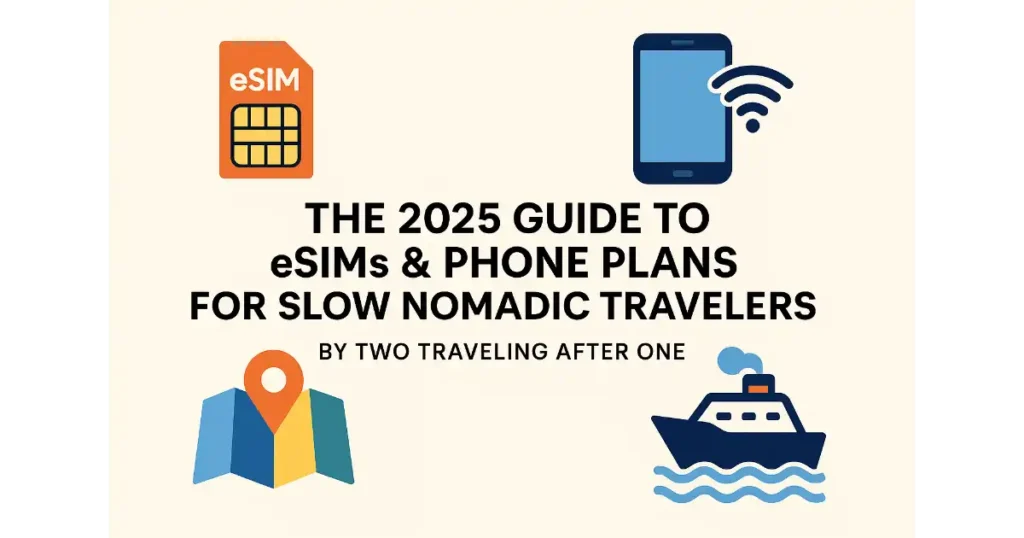
Quick Picks by Scenario
- 1–3 month stay in one country: Purchase a local carrier plan (physical SIM or local eSIM) upon arrival. Use a low-cost provider in the US, Canada, or Europe (Your Home Country) for a home line that supports banking texts and Wi-Fi calling.
Here are the top-value U.S. providers that offer reliable SMS for banking and 2FA, as well as Wi-Fi calling support, making them ideal as a backup “anchor line” at home. This list is ranked based on the combined price point and value, flexibility, user ratings, and strategic fit for nomadic travelers who need phone/text continuity.
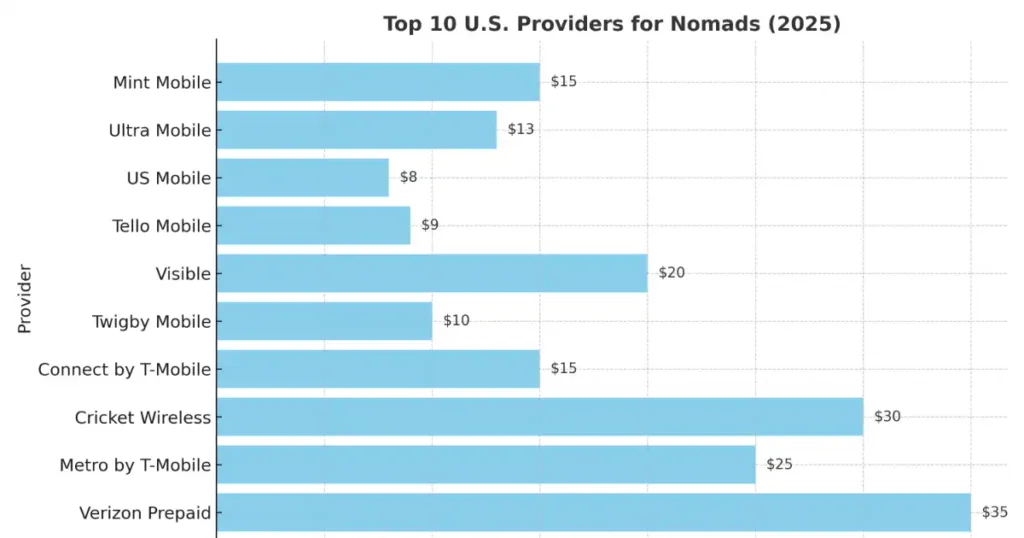
Top 10 US Providers (Value + Connectivity Features)
- Mint Mobile
- Plans start at $15/month (introductory offer), with 5 GB+ data and hotspot included, great long-term value.
- Ultra Mobile
- From $13/month for 4 GB (single-month), generous hotspot (25 GB unlimited plan), international texting/calling.
- US Mobile
- Custom “light” plans as cheap as $8/month (annual pay), support Wi‑Fi calling, and international roaming on some tiers.
- Tello Mobile
- Flexible plans start at a very low price, earning top ratings for affordability and user experience.
- Visible
- Unlimited data/hotspot for around $20–$35/month. Suitable for simplicity and shareable hotspot. (What we use currently)
- Twigby Mobile
- Introductory offers from $10/month for talk/text-only; unlimited plans around $35/month, include hotspot and international texts.
- T-Mobile
- Plans start at $15/month for 5 GB, with higher tiers offering up to 12 GB. Includes Wi‑Fi calling and tethering.
- Cricket Wireless (AT&T)
- Talk/text with 5 GB data for $30/month. Owned by AT&T; solid reliability.
- Metro by T‑Mobile
- Similar to AT&T above, with unlimited data options, starting $25/month (autopay required for price point).
- Verizon Prepaid
- Unlimited talk/text plus 15 GB data for $35/month (autopay required).
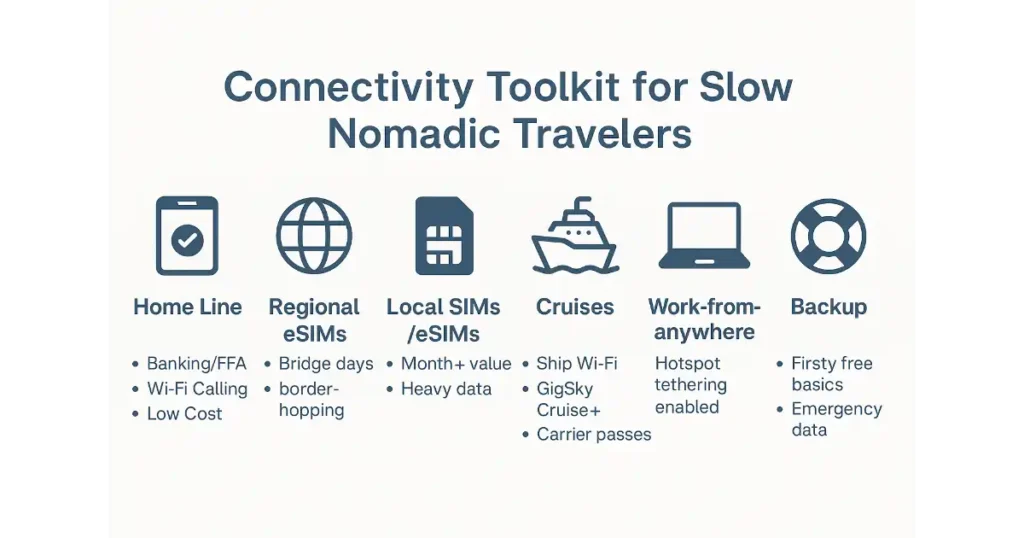
Why These Work for Slow Travelers:
- Reliable SMS for banking and 2FA is a critical functionality not dependent on data.
- Wi-Fi Calling support means you still receive messages and calls even when traveling abroad.
- Low monthly cost ensures your anchor line doesn’t break the bank.
- Many plans and devices support hotspot tethering, which allows users to share data in emergencies.
- Multi-country within Europe: Use an EU plan that includes roaming across the EU/EEA (also known as “Roam Like at Home,” extended to 2032). Add short eSIM top-ups between moves if needed.
- Multi-country outside Europe (SEA/LatAm): Start with a regional eSIM for the first 7–10 days (Airalo/Nomad/GigSky/UbiGi), then switch to a local plan for month-long stays.
- Cruise travel: eSIMs work in ports, not at sea (unless you buy a maritime plan). Use the ship’s Wi-Fi, an independent provider like GigSky Cruise+ (the best option for long cruises where data is a must), or a carrier cruise pass (e.g., Verizon Cruise Daily Pass, $20/day, AT&T Cruise IDP, $20/day).
- “I already have a US plan”:
- Work-from-anywhere + hotspot sharing: Choose an eSIM provider that explicitly allows tethering (e.g., Nomad, Airalo, GigSky; Holafly varies by plan, always check).
- Ultra-budget backup: Install Firsty for ad-supported free basics (messages/maps), then upgrade only on heavy days. Great in a pinch.
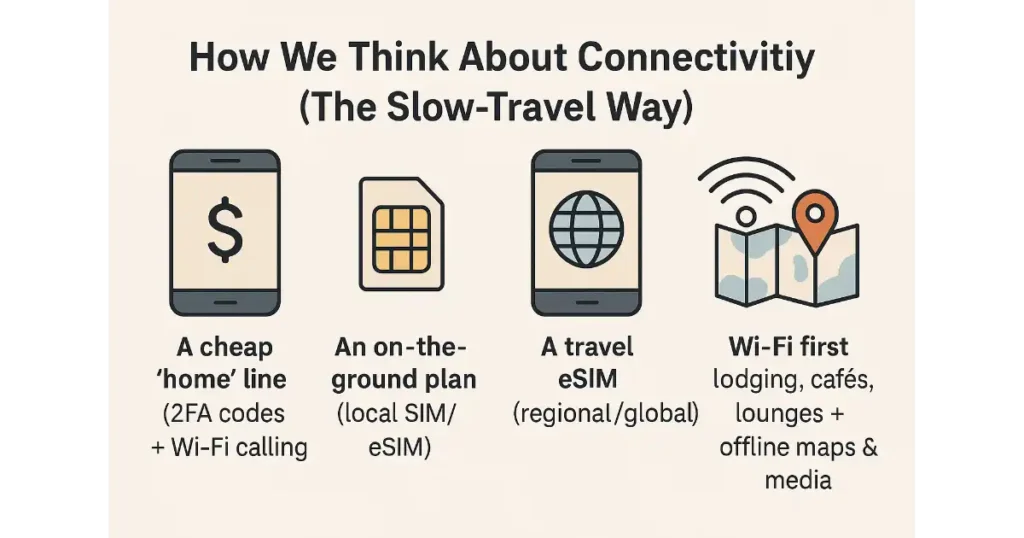
How we think about connectivity (the slow-travel way)
Our rule of thumb: don’t pay for high-speed data every single day. Instead, assemble a toolkit:
- A cheap “home” line (for 2FA codes + Wi-Fi calling)
- An on-the-ground plan (local SIM/eSIM) for a month-long value
- A travel eSIM (regional/global) for bridges (arrival week, border days, surprise outages)
- Wi-Fi first (lodging, cafés, lounges) + offline maps & media
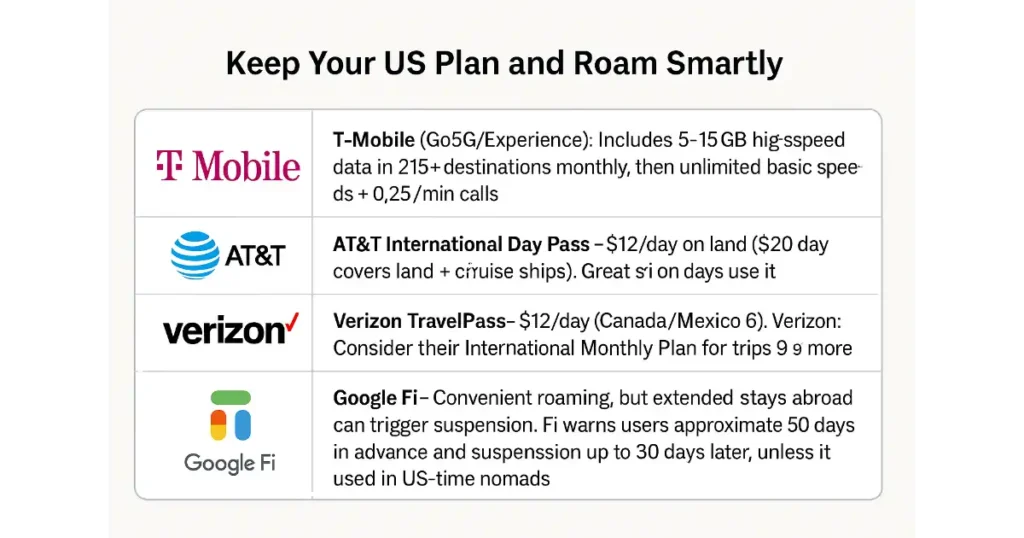
The Core Options (and when each wins)
1) Keep your US plan and roam smartly
- T-Mobile (Go5G/Experience) – Includes 5–15GB high-speed data in 215+ destinations monthly, then unlimited basic speeds + $0.25/min calls. Add inexpensive International Passes on heavy weeks. Ideal for travelers who want one bill and predictable coverage.
- AT&T International Day Pass – $12/day on land ($20/day covers land + cruise ships), charged only on days you use it. Great if you roam just a few days/month.
- Verizon TravelPass – $12/day (Canada/Mexico $6). Works well for short bursts; consider their International Monthly Plan for trips lasting 9 days or more.
- Google Fi – Convenient roaming, but extended stays abroad can trigger suspension. Fi warns users approximately 50 days in advance and can suspend service up to 30 days later, unless data is used in the US again. Not ideal for full-time nomads.
Google Fi vs. Google Voice
Google Fi
- ✅ One-line roaming solution in 200+ countries
- ✅ Wi-Fi calling included
- ⚠️ Risk of suspension if abroad too long
- 👎 Expensive for heavy users
Google Voice
- ✅ Keeps your U.S. number in the cloud
- ✅ Free calls/texts to U.S. numbers via Wi-Fi/data
- ✅ No “U.S. usage” requirement — ideal for nomads
- ⚠️ Some banks don’t send OTP texts to Google Voice
- ⚠️ Data still needed via eSIM/local SIM
Rule of thumb: If you’re U.S.-based with frequent but short trips, Fi is a good option. If you’re a full-time nomad, Voice + travel eSIMs/local SIMs is the safer combo.
Why/When to choose this: You want simplicity, strong fallback coverage, and you don’t need loads of hotspot data every day. You plan on returning to the US every few months.
2) Travel eSIM marketplaces (plug-and-play, no contracts)
Well-known options include Airalo, Nomad, GigSky, Ubigi, Holafly, SimOptions (Orange Holiday eSIM), Flexiroam (even in-flight), and Firsty (free basic data). Independent testing and roundups shift, but recent 2025 overviews highlight Ubigi and Airalo/Nomad for coverage/value, Holafly for unlimited-style plans, GigSky for cruise-friendly options, and Flexiroam for in-flight data.
- Tethering (hotspot): Supported by Nomad, Airalo, and GigSky. Holafly now offers a hotspot on select plans, but the terms vary depending on the plan. Please refer to the specific plan page, which can be accessed via these links.
- Voice/SMS needs: Most eSIMs are data-only. If you need minutes/SMS, consider the Orange Holiday Europe eSIM (which includes a French +33 number, minutes & texts).
- In-flight connectivity: Flexiroam sells airline-specific in-flight eSIM passes. Handy for long hauls without paid Wi-Fi.
- Free backup: Firsty offers ad-supported free basics worldwide; you can upgrade to paid tiers daily.
Why/when to choose this: Landing in a new country? Need data in minutes? Want a regional plan for border-hopping? eSIMs are fast, flexible, and perfect as a “bridge” until you buy a local plan.
3) Local carrier plans (best value for month-long stays)
If you’re living somewhere 4+ weeks, a local carrier plan (physical SIM or local eSIM) almost always beats travel eSIM pricing, especially for heavy hotspotting and uploads. In the EU/EEA, purchasing a plan in one country and roaming across member states is often permitted under the “Roam Like at Home” initiative.
Pro tip: Pick a provider with a storefront near your lodging. Bring your passport for SIM registration. Ask about eSIM availability, hotspot allowance, and top-up apps before making a payment.
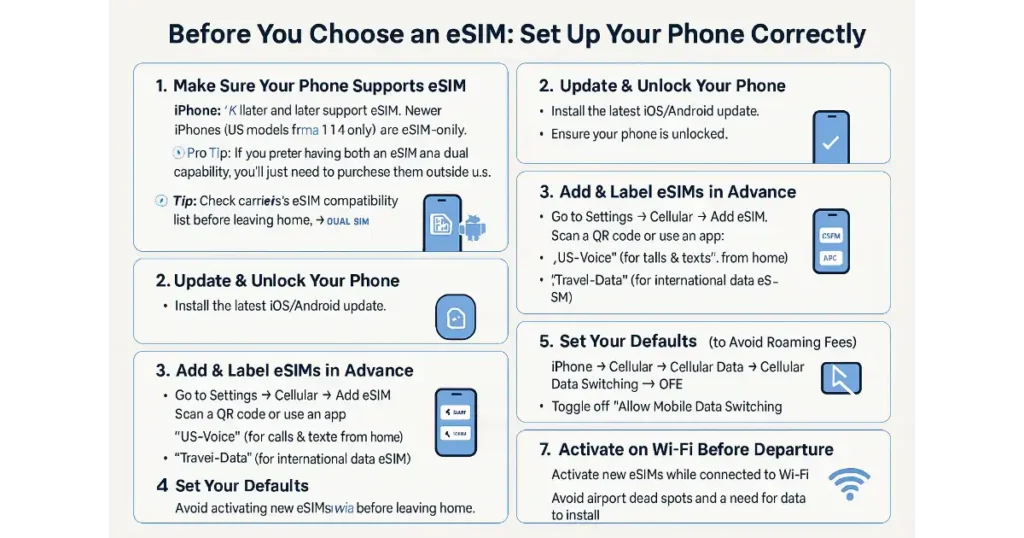
Before You Choose an eSIM: Set Up Your Phone Correctly
Buying the right eSIM or SIM plan is only half the battle. If your phone isn’t set up correctly, you can end up with surprise roaming charges, lost service, or headaches switching lines. Here’s how to get your device ready before you travel.
- Make Sure Your Phone Supports eSIM
- iPhone: iPhone XS and later support eSIM. Newer iPhones (US models from the iPhone 14 onward) are eSIM-only.
Pro Tip: If you prefer having both an eSIM and a physical SIM slot, you can still get newer iPhone models with dual capability; you’ll just need to purchase them outside the U.S.
- Android: The most recent Google Pixel, Samsung Galaxy, and other flagship models support eSIM (check “Settings > Connections > SIM Manager” or a similar option).
- Dual SIM setup: iPhones and many Android devices let you run two lines simultaneously (one for your US number and one for travel data).
👉 Tip: Check your carrier’s eSIM and Duel SIM compatibility list before leaving home.
- Update & Unlock Your Phone
- Install the latest iOS/Android update.
- Ensure your phone is unlocked (otherwise, local SIMs won’t work). Call your carrier if unsure.
- Add & Label eSIMs in Advance
- On iPhone:
- Go to Settings → Cellular → Add eSIM.
- Scan the QR code or use the app (e.g., Airalo, Nomad, GigSky).
- Label lines clearly, e.g.:
- “US-Voice” (for calls & texts from home)
- “Travel-Data” (for international data eSIM)
- On Android (Samsung/Pixel):
- Go to Settings → Connections → SIM Manager → Add Mobile Plan.
- Install via QR code or carrier app.
- Label lines (same idea as above).
- On iPhone:
- Set Your Defaults
- Default Voice Line: Keep your US line active for calls/SMS (especially banking codes).
- Default Data Line: Switch to your travel eSIM upon arrival on land.
- Wi-Fi Calling: Turn this ON for your US line so you can make/receive calls over Wi-Fi anywhere.
- Control Data Switching (to Avoid Roaming Fees)
- On iPhone: Settings → Cellular → Cellular Data → Cellular Data Switching → OFF.
- On Android: Toggle off “Allow Mobile Data Switching.”
This ensures your US line won’t silently use roaming data in the background.
- Set up (Activate) your eSIM on Wi-Fi Before Departure
- Always set up new eSIMs while connected to Wi-Fi (either at home or in a hotel) before you need them.
- This avoids airport dead spots and the need for data to install.
- Test Before You Fly ✈️
- Toggle between lines to make sure calls, texts, and data work.
- Check hotspot/tethering if you plan to share data with laptops/tablets.
- Download offline maps, translation packs, and entertainment as a backup.
✅ With this setup, you can switch between eSIMs in seconds, keep your US number alive for important codes, and control costs without surprises.
Certain Cases (where slow travelers get burned)
Cruises (sea days vs. port days)
- At sea: Regular eSIMs won’t work (no land towers). Use ship Wi-Fi, GigSky Cruise+ eSIM, or a carrier cruise pass (e.g., GigSky, prices vary, Verizon Cruise, $20/day; AT&T IDP Cruise, $20/day).
- In port: Your travel/local eSIM works normally on land networks.
- Safety tip: Keep phones in Airplane Mode at sea to avoid “Cellular at Sea” surprise charges.
Banking, 2FA, and iMessage/WhatsApp
Keep your US number active (even on a cheap plan) for SMS codes. Use Wi-Fi Calling to place/receive calls over Wi-Fi (on iPhone: Settings → Cellular/Mobile → Wi-Fi Calling). Note: With T-Mobile, Wi-Fi calls to US numbers are free; however, calls to other countries over Wi-Fi may be billed according to your plan.
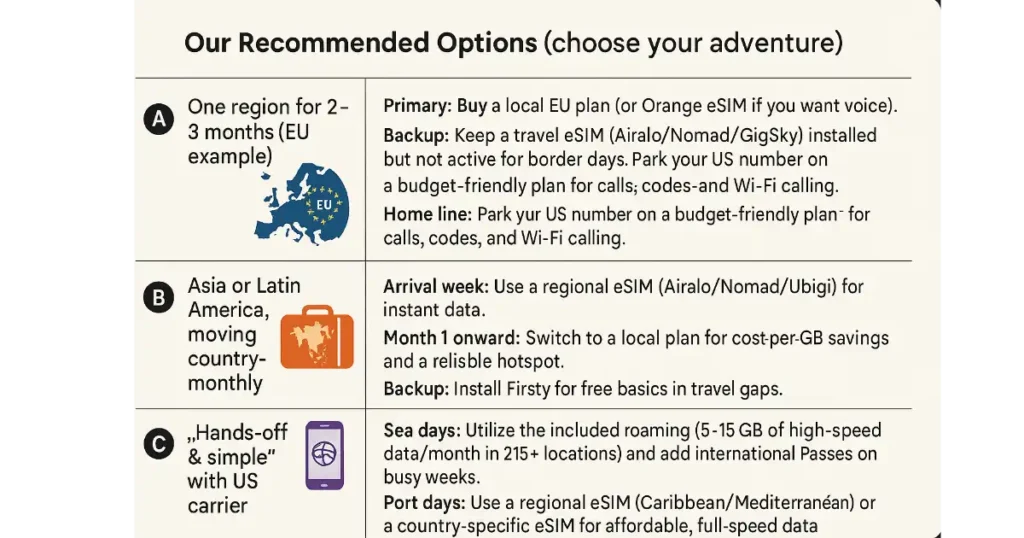
Our Recommended Options (choose your adventure)
A) One region for 2–3 months (EU example)
- Primary: Buy a local EU plan (or Orange eSIM if you want voice). EU “roam like at home” covers cross-border trips.
- Backup: Keep a travel eSIM (Airalo/Nomad/GigSky) installed but not active for border days.
- Home line: Park your US number on a budget-friendly plan for calls, codes, and Wi-Fi calling.
B) Asia or Latin America, moving country-to-country monthly
- Arrival week: Use a regional eSIM (Airalo/Nomad/Ubigi) for instant data.
- Month 1 onward: Switch to a local plan for cost-per-GB savings and a reliable hotspot.
- Backup: Install Firsty for free basics in travel gaps.
C) “Hands-off & simple” with a US carrier
- T-Mobile: Utilize the included roaming (5–15GB of high-speed data/month in 215+ locations) and add International Passes on busy weeks.
- AT&T or Verizon: Keep Day Passes off by default; switch them on only when you genuinely need full-speed data or voice.
D) Cruises + land pre/post
- Sea days: Buy the ship’s Wi-Fi, GigSky Cruise+, or a carrier cruise pass (GigSky/Verizon/AT&T), and have airplane Mode on at sea.
- Port days: Use a regional eSIM (Caribbean/Mediterranean) or a country-specific eSIM for affordable, full-speed data.
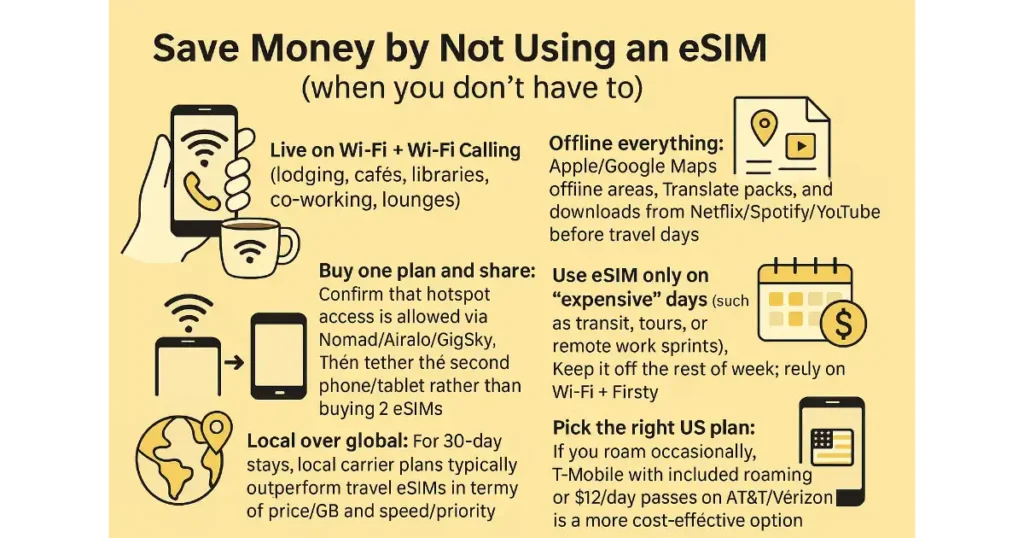
Save Money by Not Using an eSIM (when you don’t have to)
- Live on Wi-Fi + Wi-Fi Calling (lodging, cafés, libraries, co-working, lounges). Enable Wi-Fi Calling on your iPhone; calls to US numbers can be free on T-Mobile, even when abroad.
- Offline everything: Apple/Google Maps offline areas, Translate packs, and downloads from Netflix/Spotify/YouTube before travel days.
- Buy one plan and share: Confirm that hotspot access is allowed via these links (Nomad/Airalo/GigSky, which currently indicate ‘yes’; Holafly depends on the plan you select). Then tether the second phone/tablet rather than buying 2 eSIMs.
- Use eSIM only on “expensive” days (such as transit, tours, or remote work sprints). Keep it off the rest of the week; rely on Wi-Fi + Firsty.
- Local over global: For 30-day stays, local carrier plans typically outperform travel eSIMs in terms of price/GB and speed/priority.
- Pick the right US plan: If you roam occasionally, T-Mobile with included roaming or $12/day passes on AT&T/Verizon is a more cost-effective option than purchasing travel eSIMs every week.
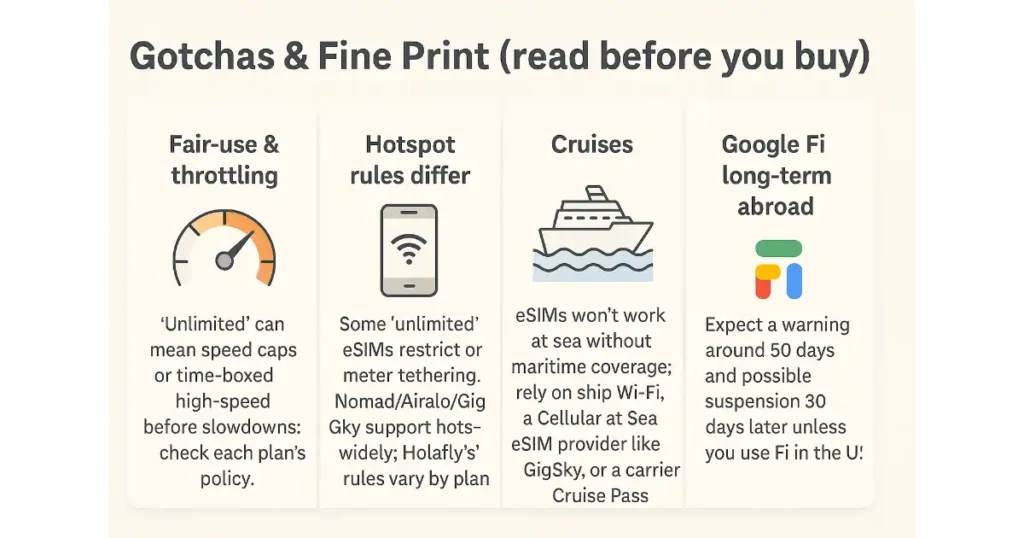
Gotchas & Fine Print (read before you buy)
- Fair-use & throttling: “Unlimited” can mean speed caps or time-boxed high-speed before slowdowns; check each plan’s policy.
- Hotspot rules differ: Some “unlimited” eSIMs restrict or meter tethering. Nomad/Airalo/GigSky support hotspots widely; Holafly’s rules vary by plan (some pages tout unlimited hotspot; others mention daily hotspot allotments). Always confirm the plan details on the plan page you’re buying.
- Cruises: eSIMs won’t work at sea without maritime coverage; rely on ship Wi-Fi, a Cellular at Sea eSIM provider like GigSky, or a carrier Cruise Pass.
- Google Fi long-term abroad: Expect a warning around 50 days and possible suspension 30 days later unless you use Fi in the US. (This is not 100%, but it does happen)

Our current “2TravelingAfter1” kit
What We Actually Carry
- US anchor line: A low-cost US plan for the phone number (bank codes + Wi-Fi calling).
- Travel data: A Nomad/Airalo/GigSky regional eSIM preinstalled for instant coverage on arrival + border days.
- Local plan: If we’re staying a month or more, we switch to a local carrier for the best price/GB and hotspotting.
- Cruises: Airplane Mode at sea + ship Wi-Fi; port-day eSIM for land time; consider carrier cruise pass only if we truly need cellular at sea.
- Emergency backup: Firsty, installed for free basics in case everything else fails.
Making a Decision
- Staying 4+ weeks in one country? Get a local plan.
- Hopping countries every 7–14 days? Use a regional eSIM + occasional local top-ups.
- Cruising? Ship Wi-Fi or Cruise Pass, GigSky Cruise+ eSIM in ports.
- Already on T-Mobile? You might be done. Check your plan’s 5–15GB high-speed roaming bucket before buying anything else.
- Rely on voice/SMS? Consider the Orange eSIM (including voice and SMS) when in Europe.
Extra credit: Power moves for pros
- Dual-network redundancy (US): Some carriers/MVNOs now allow you to add a second US network via eSIM, so your phone automatically chooses the stronger signal, which is particularly handy for rural US stints between trips.
- Family hotspot strategy: One big plan + everyone tethers (confirm hotspot rules first).
Pro Tip: Label eSIMs by country and don’t delete reusable ones; many providers allow top-ups at a lower cost later.
Final notes on Europe & dual-SIM logistics
- EU Roam Like at Home runs through 2032, so an EU SIM often covers your cross-border moves.
The iPhone supports multiple stored eSIMs and allows two to be active simultaneously, making it perfect for keeping your US line for calls/SMS while using a travel/local eSIM for data.

Final Thoughts
The truth is, there’s no one-size-fits-all solution for staying connected abroad. The best strategy is to mix and match: use a cheap home line for banking and security, local SIMs for extended stays, eSIMs for flexibility, and Wi-Fi calling to save money whenever possible. By layering these options, you gain both freedom and peace of mind, as well as the ability to work, connect, and explore without worrying about your phone bill.
We also understand how rapidly this space evolves. New eSIM providers, updated carrier rules, and shifting international roaming policies. That’s why we recommend bookmarking this blog. We plan to keep it current and up to date so it can remain a go-to resource for every traveler who’s ever struggled to figure out SIMs, eSIMs, and staying connected on the road.
Slow travel is about enjoying the journey. With the right setup, your phone plan shouldn’t slow you down; it should support the lifestyle you’ve worked so hard to create.
FAQ's
Do I need an international calling plan?
Usually no. Use data apps (such as FaceTime/WhatsApp/Zoom) and Wi-Fi Calling on your home line when needed.
Can I keep my U.S. number without paying a lot?
Yes—move to a low‑cost MVNO with Wi‑Fi Calling and minimal minutes/data.
Will my bank send OTP texts to a VoIP?
Sometimes. It’s inconsistent. Test it before relying on it, and prefer app-based MFA.
eSIM or local SIM?
eSIM for convenience/short stays, local SIM for extended stays/heavy data.
Is there an eSIM Carrier at Sea?
Yes — GigSky Cruise+ is currently the only widely available eSIM option designed specifically for cruise travelers. Unlike standard travel eSIMs, which only work when you’re connected to land-based cell towers, GigSky Cruise+ provides maritime coverage at sea plus regular data in port.





